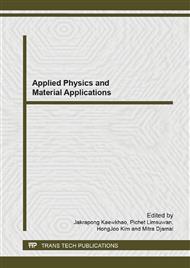p.76
p.80
p.84
p.88
p.92
p.96
p.100
p.104
p.108
Design and Synthesis of Ruthenium (II) Complexes and their Applications in Dye Sensitized Solar Cells (DSSCs)
Abstract:
Three thiocyanate-free ruthenium (II) sensitizers, [RuII(dcppy)(L1-L3)](PF6)] where dcppy = 4, 4-dicarboxylic acid-2, 2-bipyridine, L1 = 2-(2,4-difluorophenyl)-5-(trifluoromethyl) pyridine, L2 = 2-(2,4-difluorophenyl) pyridine and L3 = 2-phenyl-5-(trifluoromethyl) pyridine were synthesized and applied for dye-sensitized solar cells (DSSCs). The structures of ruthenium complexes were characterized by 1H, 13C NMR and IR spectra. The absorption was studied by UV-Vis spectroscopy and the electrochemical property was determined by cyclic voltammetry. The surface morphology of ruthenium complexes on mica was examined by atomic force microscopy. The performance of this complexes as photosensitizer in TiO2 based dye sensitized solar cells is studied under standard AM 1.5 sunlight and by using an electrolyte.
Info:
Periodical:
Pages:
92-95
Citation:
Online since:
September 2013
Authors:
Price:
Сopyright:
© 2013 Trans Tech Publications Ltd. All Rights Reserved
Share:
Citation:



